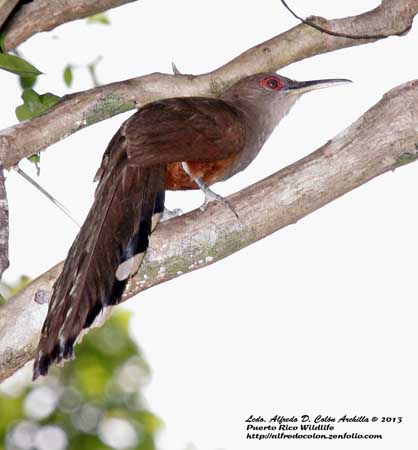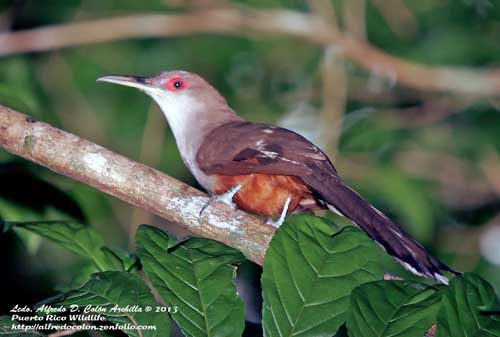
Fr: Tacco de Porto Rico
All: Puerto-Rico-Kuckuck
Esp: Cuco-lagartero Portorriqueño
Puerto Rico: Pájaro Bobo Mayor
Ita: Cuculo lucertola di Portorico
Nd: Puertoricaanse Hagediskoekoek
Sd: Puerto Ricoödlegök
Photographer:
Alfredo Colón
Puerto Rico Wildlife
Text by Nicole Bouglouan
Sources:
HANDBOOK OF THE BIRDS OF THE WORLD vol 4 by Josep del Hoyo-Andrew Elliott-Jordi Sargatal - Lynx Edicions - ISBN: 8487334229
BirdLife International (BirdLife International)
Aves de Porto Rico – Sociedad Ornitológica Puertorriqueña
Neotropical Birds – Cornell Lab of Ornithology
Wikipedia, the free encyclopaedia
Puerto Rican Lizard Cuckoo
Coccyzus vieilloti
Cuculiformes Order – Cuculidae Family
INTRODUCTION:
The Puerto Rican Lizard Cuckoo is endemic to the island of Puerto Rico. Formerly placed in the genus “Saurothera” with the three other Caribbean species, they are now included in the genus “Coccyzus”.
The scientific name C. vieilloti pays tribute to the French ornithologist Luis Jean Pierre Vieillot who has described numerous species from West Indies and North America.
DESCRIPTION OF THE BIRD:
Biometrics:
Length: 42 cm
Weight: 80 g
The adult has grey-brown washed rufous upperparts, including the upperwing. The long tail is similar in colour but shows black subterminal bars and broad white tips.
On the underparts, chin and throat are white. The breast is pale grey, contrasting with the rufous belly and vent.
On the head, forehead, crown and nape are like the back.
The long, straight bill is blackish above and pale yellow on the lower mandible. The eyes are brown, surrounded by conspicuous bright red bare skin. Legs and feet are dark bluish-grey.
Both sexes are similar.

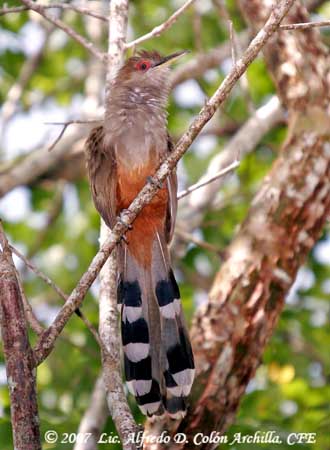
The juvenile has brown upperparts with rufous-edged feathers. On the underparts, the colours are paler and duller than in adults. The tail is narrower and paler too, with broad black bands and more pointed white tips. The bare skin around the eyes is rather orange-red than bright red.
RANGE:
The Puerto Rican Lizard Cuckoo is found on the island of Puerto Rico.
HABITAT:
The Puerto Rican Lizard Cuckoo is a forest species, and it frequents both tropical deciduous and lowland evergreen forests, but also woodlands, coffee plantations and brushy limestone hills. This species is visible from lowlands up to 800 metres of elevation.
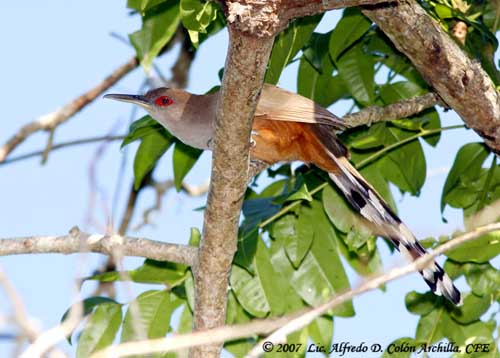
CALLS AND SONGS: SOUNDS BY XENO-CANTO
The Puerto Rican Lizard Cuckoo gives soft low “caw” calls.
The song is a rapid series “ka-ka-ka-ka” accelerating and becoming louder, usually described as “cao cao, cuc cruc” in Puerto Rico.
BEHAVIOUR IN THE WILD:
The Puerto Rican Lizard Cuckoo feeds primarily on small lizards (75% of its diet), but it also takes large spiders, large insects, and especially stick insects, and caterpillars.
It forages by moving slowly at mid-level and in canopy. Is removes or lifts small pieces of bark off tree trunks, and dead parts off cacti, in order to disturb the concealed preys and to catch them. It may sometimes glean on the ground. It often approaches the preys on foot rather than by flying.
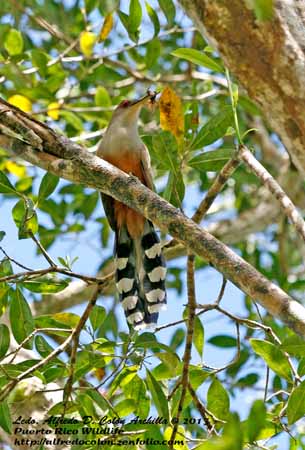
The Puerto Rican Lizard Cuckoo has regular territory where it remains for long periods through the year. It often sits motionless in the dense foliage, turning slightly the head or twisting the neck. After rain, it can be seen in the open while drying-off and preening its feathers.
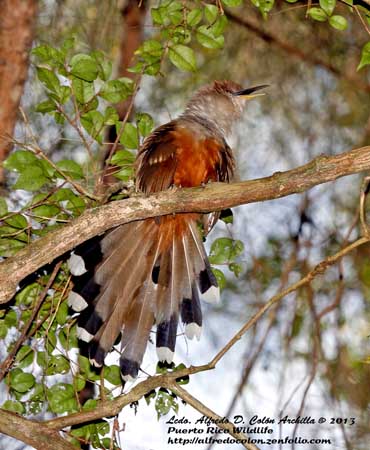
During the breeding season, the Puerto Rican Lizard Cuckoo performs courtship displays. The tail is fanned and raised to expose the conspicuous black-and-white pattern, the wings are lowered while the bill is pointed upwards. The bird sings loudly during these displays.
Courtship feeding is observed throughout the nesting cycle.
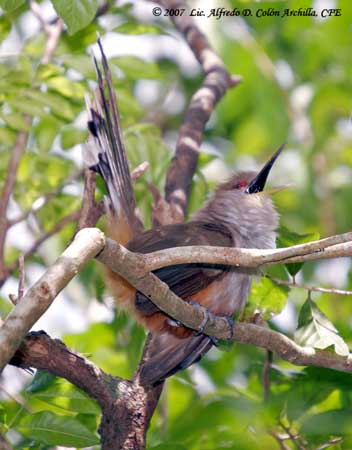
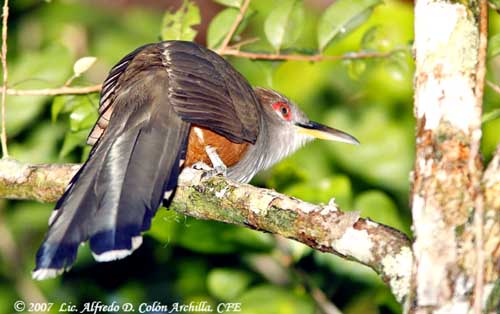
The Puerto Rican Lizard Cuckoo is resident in its range, and probably maintains and defends its territory all year round. It does not migrate and only performs short-distance flights.
This species has relatively short wings as all forest-living Cuculidae species, and mainly performs gliding flight among the trees.
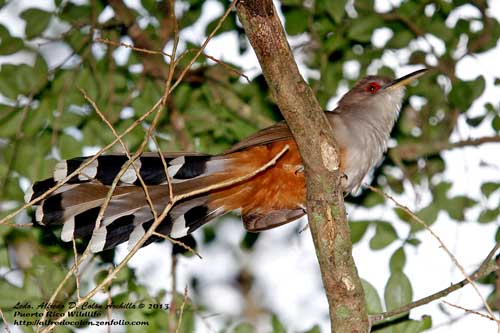
REPRODUCTION OF THIS SPECIES:
With several breeding records through the year (April, May, September, November and December), we can suggest that the Puerto Rican Lizard Cuckoo may breed at any time.
The nest is a loose platform made with sticks and leaves, placed in tree or in large bush.
The female lays 2-3 pale blue eggs.
There is no more information about the nesting period.
Unlike numerous cuckoos, the Puerto Rican Lizard Cuckoo is not a brood-parasite for other bird species.
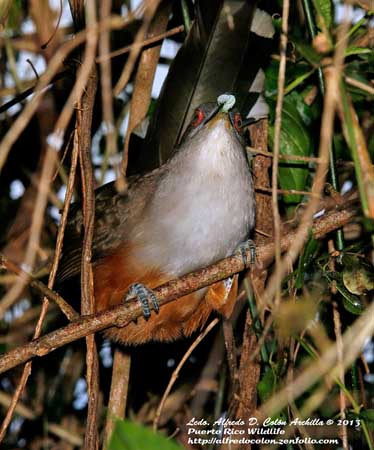
PROTECTION / THREATS / STATUS:
The Puerto Rican Lizard Cuckoo has restricted range in which it is usually fairly common or even common in forested areas. However, it can be locally rare.
Currently, its populations are stable and this species is not globally threatened.
